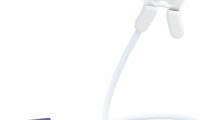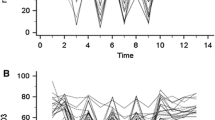Abstract
Purpose
There is clinical significance to a delay in response time for detecting desaturation by pulse oximetry. Our aim in this study was to compare the response time of the reflectance and transmittance saturation probes during fiberoptic bronchoscopy (FOB) under monitored anesthesia care.
Methods
A prospective study included 104 patients scheduled for FOB. Patients were monitored with transmittance (finger) and reflectance (ear) oximetry probes. The response time was evaluated during desaturation and resaturation. We also acquired blood tests for arterial oxygen saturation to assess the agreement with the oximetry probes.
Results
Ninety patients had a desaturation episode during FOB and were included in the final analysis. Mean time difference between the reflectance ear probe (reference probe) and transmittance finger probe for the detection of desaturation (SpO2 = 90%) was + 36 s (CI 27.0–45.0, P < 0.001). The time difference between probes at end of desaturation episode (SpO2 = 95%) was + 31 s (CI 19.0–43.0; P < 0.001). A significant difference in response time was evident throughout the episode in all saturation values. The reflectance ear probe showed better agreement with arterial blood gases. The bias (and precision) for the earlobe and finger oximeters were of 0.24 (1.04) and 2.31 (3.37), respectively.
Conclusion
The data displayed by a centrally located reflectance probe are more accurate and allows for earlier identification, treatment, and resolution of desaturation events. In light of these data and the added value of the reflectance probe ability to measure transcutaneous PCO2, we recommend monitoring bronchoscopy by a reflectance oximetry probe.


Similar content being viewed by others
Abbreviations
- FOB:
-
Fiberoptic bronchoscopy
- ABG:
-
Arterial blood gases
- SpO2 :
-
Pulse oximeter saturation
References
Tremper KK, Barker SJ (1989) Pulse oximetry. Anesthesiology 70(1):98–108
Severinghaus JW, Kelleher JF (1992) Recent developments in pulse oximetry. Anesthesiology 76(6):1018–1038
Wahr JA, Tremper KK (1995) Noninvasive oxygen monitoring techniques. Crit Care Clin 11(1):199–217
Pretto JJ, Roebuck T, Beckert L, Hamilton G (2014) Clinical use of pulse oximetry: official guidelines from the Thoracic Society of Australia and New Zealand. Respirology 19(1):38–46
Pedersen T, Nicholson A, Hovhannisyan K, Moller AM, Smith AF, Lewis SR (2014) Pulse oximetry for perioperative monitoring. Cochrane Database Syst Rev. https://doi.org/10.1002/14651858.CD002013.pub3
Du Rand IA, Blaikley J, Booton R, Chaudhuri N, Gupta V, Khalid S et al British Thoracic Society guideline for diagnostic flexible bronchoscopy in adults: accredited by NICE. Thorax 2013;68(Suppl 1):i1-i44
Severinghaus JW, Naifeh KH, Koh SO (1989) Errors in 14 pulse oximeters during profound hypoxia. J Clin Monit 5(2):72–81
Trivedi NS, Ghouri AF, Lai E, Shah NK, Barker SJ (1997) Pulse oximeter performance during desaturation and resaturation: a comparison of seven models. J Clin Anesth 9(3):184–188
Choi SJ, Ahn HJ, Yang MK, Kim CS, Sim WS, Kim JA et al (2010) Comparison of desaturation and resaturation response times between transmission and reflectance pulse oximeters. Acta Anaesthesiol Scand 54(2):212–217
Schallom L, Sona C, McSweeney M, Mazuski J (2007) Comparison of forehead and digit oximetry in surgical/trauma patients at risk for decreased peripheral perfusion. Heart Lung 36(3):188–194
Fernandez M, Burns K, Calhoun B, George S, Martin B, Weaver C (2007) Evaluation of a new pulse oximeter sensor. Am J Crit Care 16(2):146–152
Nuhr M, Hoerauf K, Joldzo A, Frickey N, Barker R, Gorove L et al (2004) Forehead SpO2 monitoring compared to finger SpO2 recording in emergency transport. Anaesthesia 59(4):390–393
MacLeod DB, Cortinez LI, Keifer JC, Cameron D, Wright DR, White WD et al (2005) The desaturation response time of finger pulse oximeters during mild hypothermia. Anaesthesia 60(1):65–71
Wax DB, Rubin P, Neustein S (2009) A comparison of transmittance and reflectance pulse oximetry during vascular surgery. Anesth Analg 109(6):1847–1849
Bebout D, Mannheimer P (2002) Effects of cold-induced peripheral vasoconstriction on pulse amplitude at various pulse oximeter sensor sites. Anesthesiology. https://doi.org/10.1097/00000542-200209002-00558
Bebout DE, Asbagh NA (2002) Detection of hypoxemia during peripheral vasoconstriction at the radial artery and various pulse oximeter sensor sites. Crit Care Med 30(12):328
Bland JM, Altman DG (1999) Measuring agreement in method comparison studies. Stat Methods Med Res 8(2):135–160
Bland JM, Altman DG (1986) Statistical methods for assessing agreement between two methods of clinical measurement. Lancet 1(8476):307–310
Bickler PE, Feiner JR, Lipnick MS, Batchelder P, MacLeod DB, Severinghaus JW (2017) Effects of acute, profound hypoxia on healthy humans: implications for safety of tests evaluating pulse oximetry or tissue oximetry performance. Anesth Analg 124(1):146–153
Geraci G, Pisello F, Sciume C, Li Volsi F, Romeo M, Modica G (2007) Complication of flexible fiberoptic bronchoscopy. Literature review. Ann Ital Chir 78(3):183–192
Stahl DL, Richard KM, Papadimos TJ (2015) Complications of bronchoscopy: a concise synopsis. Int J Crit Illn Inj Sci 5(3):189–195
Dreisin RB, Albert RK, Talley PA, Kryger MH, Scoggin CH, Zwillich CW (1978) Flexible fiberoptic bronchoscopy in the teaching hospital. Yield Complications. Chest 74(2):144–149
Pereira W, Kovnat DM, Snider GL (1978) A prospective cooperative study of complications following flexible fiberoptic bronchoscopy. Chest 73(6):813–816
Suratt PM, Smiddy JF, Gruber B (1976) Deaths and complications associated with fiberoptic bronchoscopy. Chest 69(6):747–751
Fruchter O, Carmi U, Ingenito EP, Refaeli Y, Kramer MR (2011) Transcutaneous carbon dioxide in severe COPD patients during bronchoscopic lung volume reduction. Respir Med 105(4):602–607
Evans EN, Ganeshalingam K, Ebden P (1998) Changes in oxygen saturation and transcutaneous carbon dioxide and oxygen levels in patients undergoing fibreoptic bronchoscopy. Respir Med 92(5):739–742
Carmi U, Kramer MR, Zemtzov D, Rosengarten D, Fruchter O (2011) Propofol safety in bronchoscopy: prospective randomized trial using transcutaneous carbon dioxide tension monitoring. Respiration 82(6):515–521
Yazawa R, Gamo M, Kokawa A, Hirose Y (2008) Are transcutaneous blood gas measurement monitors (SenTec Digital Monitor system) useful for the respiratory management of chronic respiratory failure? Masui 57(4):453–456
Author information
Authors and Affiliations
Corresponding author
Ethics declarations
Conflict of interest
All authors declare that they have no conflict of interest.
Rights and permissions
About this article
Cite this article
Pertzov, B., Brachfeld, E., Unterman, A. et al. Significant Delay in the Detection of Desaturation between Finger Transmittance and Earlobe Reflectance Oximetry Probes during Fiberoptic Bronchoscopy: Analysis of 104 Cases. Lung 197, 67–72 (2019). https://doi.org/10.1007/s00408-018-0180-0
Received:
Accepted:
Published:
Issue Date:
DOI: https://doi.org/10.1007/s00408-018-0180-0




